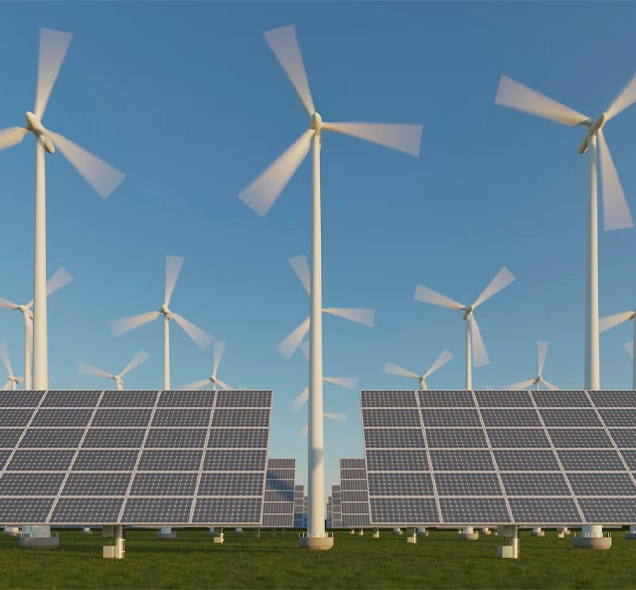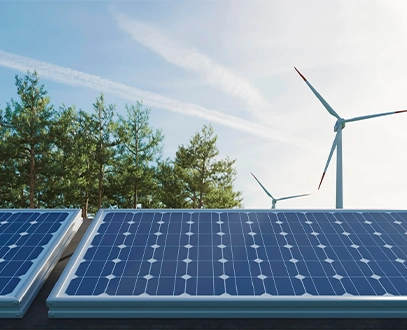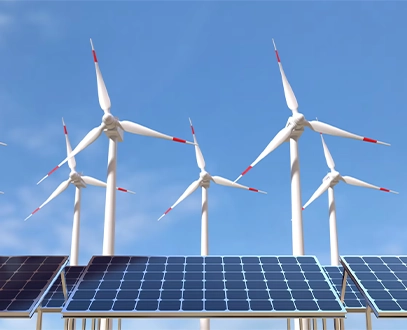Examples of renewable energy sources include solar, wind, hydroelectric, biomass and geothermal energy. These sources are types of energy that can continuously renew themselves in nature and do not carry the risk of depletion. Unlike fossil fuels, they cause less damage to the environment and significantly reduce greenhouse gas emissions. As such, they offer both environmentally friendly and economically sustainable solutions in the long term.
Examples of renewable energy sources demonstrate a wide range of application areas. Solar energy is commonly used for electricity generation on rooftops, wind energy meets energy needs in rural areas, and geothermal energy is widely used for residential heating. The adaptability of these energy types to different geographical and climatic conditions makes them attractive on a global scale. At the same time, as they rely on domestic resources, they reduce foreign dependency and contribute to energy security. For these reasons, investments in renewable energy continue to grow steadily.
Examples of Renewable Energy Sources
Renewable energy sources are types of energy that are constantly renewed through natural cycles and cause minimal damage to the environment. These sources offer cleaner, safer and more economical solutions in the long term compared to fossil fuels. In response to the ever-increasing need for energy, the trend towards renewable energy has accelerated in terms of sustainable energy production in the world and in our country. Thanks to these energy sources, carbon emissions can be reduced and foreign dependency can be reduced by increasing the use of domestic resources. These systems are critical for energy security, economic development and environmental protection.
Renewable energy sources have a wide range of uses. They can be applied in many sectors from housing to industry, agriculture to transportation. In addition, technological developments enable these resources to be used more efficiently and reduce costs. Sources such as solar, wind, hydroelectric, biomass and geothermal energy are preferred according to different climatic and geographical conditions.
Below are some prominent examples of renewable energy sources:
Can be used with photovoltaic panels and thermal systems.
Provides electricity generation with onshore and offshore turbines.
Energy is produced through rivers and dams.
It is possible to produce fuel or electricity from organic waste.
Utilizes underground sources of hot water and steam.
Each of these sources forms the cornerstone of the global energy transition.

Solar energy
Solar energy is one of the most widespread and accessible renewable energy sources. Energy is obtained by converting the sun’s rays into electricity through photovoltaic panels. This method is suitable for both individual use and large-scale power plants. Since solar energy systems operate without carbon emissions, they have a very low environmental impact.
One of the biggest advantages of solar energy is the low maintenance costs after installation. In addition, many countries have incentives, grant programs and tax advantages that support these systems. This makes solar energy investments attractive at both individual and commercial levels.
The efficiency and lifespan of solar energy systems have increased with advancing technology. Smart inverter systems, battery storage solutions and remote monitoring technologies enable users to control their energy production more effectively. These developments have made solar energy one of the most powerful energy solutions of the future.
Electricity Generation with Solar Panels
Solar panels are systems that convert sunlight directly into electricity. These panels, which are usually placed on rooftops, can be used in a wide variety of areas from residences to industry. Solar panels are widely preferred for energy generation in grid-connected or stand-alone systems.

Thermal Solar Systems
Solar thermal systems convert the sun’s rays directly into heat. These systems are often used for hot water production and are particularly common in residential buildings. It is a common heating solution thanks to its low operating costs and long lifetime.
Wind Energy
Wind energy is based on the principle of converting kinetic energy into electrical energy. The energy obtained through wind turbines gives very efficient results, especially in regions with high wind potential. Wind, a natural and unlimited resource, offers an important advantage in terms of sustainable energy production.
The installation of wind energy facilities begins with the identification of suitable geographical areas. Wind speed and direction are critical for turbine efficiency. For this reason, the areas to be installed are evaluated in advance with long-term measurements. After installation, the systems operate automatically and generate energy continuously.
Wind energy can be generated by offshore turbines as well as onshore turbines. Offshore systems can provide higher efficiency because the wind is more constant at sea. Both systems are strategically important for diversifying energy supply and reducing carbon emissions.
Onshore Wind Turbines
Onshore wind turbines are usually installed in mountainous or open areas. Installation costs are lower than for offshore turbines and maintenance access is easier. High capacity energy production can be achieved with wind farms installed in large areas.
Offshore Wind Farms
Offshore wind farms consist of large turbines installed in the sea or oceans. These systems offer high energy efficiency by utilizing constant and strong wind currents. Although installation costs are high, the return on investment is fast due to the production capacity.
Hydroelectric Energy
Hydroelectric energy enables electricity generation by utilizing the potential and kinetic energy of water. It is one of the oldest and most widely used renewable energy types. Turbines are rotated through rivers and dams and electricity is generated with the help of generators.
These systems are usually designed as large-scale power plants, but small hydroelectric power plants (HPPs) are also widely used in rural areas. Although dam construction is costly, it is advantageous in the long run due to high energy production and low operating costs. In addition, energy production can be easily adjusted depending on water demand.
Although sometimes controversial in terms of their environmental impact, hydropower systems can be an important part of sustainable energy production with proper planning and ecological balance. It contributes to energy supply security and can respond flexibly to instantaneous energy demand.
Dam Based Systems
Dam-based systems aim to generate large amounts of energy by creating large reservoirs of water. Many large hydroelectric power plants in Turkey and around the world operate with this system. Although the installation cost is high, it has a long life and high energy production capacity.

Stream Turbines
Run-of-river turbines are systems that rotate with the natural flow of water and are generally used for small-scale power generation. They have less environmental impact than dams and are effective in meeting local energy needs.



